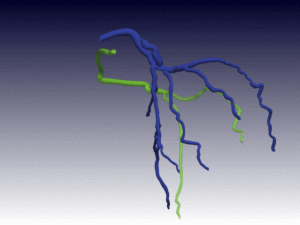A new method for automated 3D blood vessel reconstruction

Cardiovascular disease is one of the leading causes of death worldwide. Angiography is the gold standard technique for the early detection of cardiovascular diseases, as well as for the assessment of narrowing in coronary arteries. However, determining the risk of the patient suffering future cardiac complications using only angiographic images is difficult, and often other scans are required, delaying treatment decisions. The main challenge is that the angiograms are two-dimensional images and often the physicians’ experience is not enough to determine the exact location and the severity of a coronary stenosis.
Driven by this need, Oxford researchers have developed a new method for generation of 3D coronary arterial trees from retrospective angiographic projections. This new algorithm is capable of solving the motion artefacts during image acquisition and provides additional information allowing physicians to take decisions on treatment and cardiovascular risk assessment.
Angiography and its limitations
X-ray angiography is the most commonly used imaging modality for the visualisation of coronary blood vessels. Its advantages include simplicity, high spatial and temporal resolution of lumen structure, and most importantly, its utility to guide coronary interventions in real time. However, despite these clinical advantages, X-ray angiograms pose several challenges, especially in relation to visualising lesions adequately and judging lesion severity.
The 2D projections of the 3D vascular structure in different image planes produce vessel overlap and foreshortening and hence, make it difficult for the cardiologists to interpret the geometry of the object. This leads to high inter- and intra-observer variability in understanding the global anatomical structure and, in turn, affects the accuracy of the estimation of lesion severity and stent size.
The interpretation gets further complicated due to the existence of several motion artifacts, including cardiac, respiratory, and patient or device movement that occur during the acquisition. In addition, potential adverse effects of higher amount of radiographic contrast agent and exposure to X-rays limit the number of image acquisitions.
The Oxford solution
Several methods have been developed to extract 3D images from the 2D angiograms, but they have several limitations. While some of them require specific acquisition protocols to be applied when registering the images (breath-hold, no patient movement, etc.), others are only applicable on biplane angiograms and do not involve any motion correction or geometry calibration step.
Oxford researchers have developed a new algorithm using a novel point-cloud approach for robust and accurate reconstruction of 3D blood vessel trees, while removing all motion artifacts. This novel method can be applied to retrospective images and is able to reconstruct specific vascular structures.
Potential applications
This new algorithm has been developed and validated for application on coronary angiograms, but it can be applied to reconstruct other 3D structures, including brain vessels. Additionally, this novel method could enable the amalgamation of angiography and MRI assessment and therefore, would improve the current diagnostics, since at present there is no way to compare severity of the blood obstruction (angiography) and muscle injury (MRI) in the clinic.
about this technology

